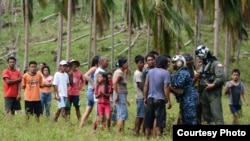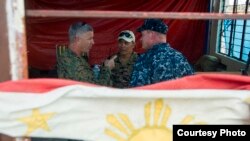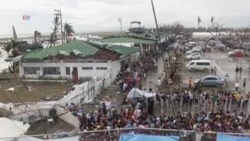MANILA —
International humanitarian officials say there is a noticeable improvement in getting aid to central Philippine communities, even if some are being reached for the first time since the typhoon struck 12 days ago. The international aid has been flowing in, exposing some of the government’s vulnerabilities. More than 4,000 people were killed and millions displaced when Typhoon Haiyan tore through the central Philippines. Hundreds of thousands have yet to be reached with emergency aid.
More than a week after Super Typhoon Haiyan battered the central provinces, President Benigno Aquino said the Philippines would be able to recover especially with the help of other countries. That was Sunday and he was touring municipalities in the eastern-most provinces that took the heaviest of Haiyan’s pounding, saying he would stay on to oversee relief and recovery operations. Two days later, he returned to Manila.
Presidential Spokesman Edwin Lacierda says Aquino noticed a significant improvement in relief goods reaching people who had nothing to eat days after the storm.
“He has expressed confidence in the work that the composite team on the ground has done. Things have turned out better than he expected,” he said.
The Philippines set a goal of releasing 150,000 food kits daily, one week after the storm. But the government was faced with logistical and infrastructure challenges, including loosening up bottlenecks at ports along waters off the hard hit provinces, clearing debris from hard to reach roads and restoring communication lines.
Officials say most issues have been resolved.
Massive aid
Dozens of governments have pledged nearly $200 million in cash and in-kind donations. A number have sent military assets bearing basic necessities and medical aid.
In addition to $30 million in financial help, Japan has sent members of its self-defense force on a medical mission to several provinces.
The United States, whose aid comes to $37 million, docked an aircraft carrier in Samar province last Thursday. Its teams worked with Philippine forces to put in place logistics that would help aid move more smoothly. And its strike force is using MV-22B Ospreys - small craft that can land vertically in remote areas.
When asked by reporters whether the government would try to convince the international community to stay on longer, Lacierda said they were here voluntarily.
“They see the need. They assess. We will leave it to them. Far [be it for] us to demand from them,” he said.
Government reaction
Richard Heydarian, a political analyst at Ateneo de Manila University in the Philippines, says the Philippine government does not want to appear too dependent on outside help, which he says has been life-saving.
“They also wanted to be quite politically correct, by not singling out some countries, thanking them, ‘Oh thank you United States and Japan.’ They didn’t want to do that. They wanted to give a generic statement in order to underplay any possible geopolitical dimensions,” he said.
Heydarian points out China’s considerably smaller portion of aid equaling $1.7 million compared to a number other countries’ and companies’ contributions. On Wednesday a China foreign ministry spokesman said it would send a medical disaster team, a Chinese Red Cross contingent and lend its 14,000 ton floating hospital the “Peace Ark” to the typhoon-ravaged area.
The Philippines and China are in the midst of a territorial squabble in the South China Sea that prompted Manila to file an arbitration case with a United Nations tribunal earlier this year.
International humanitarian agencies have been full of praise for the government’s willingness to work with other governments and outside entities, given the magnitude of the disaster.
WATCH: Related video from VOA
World Food Program Executive Director Ertharin Cousin said this week after a visit to the worst-hit parts, the Philippines has been consistently receptive.
“They have always said ‘Yes, do that.’ And that, to us, is a government that recognizes that their primary responsibility is meeting the needs of their people. And it’s our goal to continue to work with them,” said Cousin.
The United Nations says close to 13 million people have been affected by the typhoon. Its labor office says about five million people will need employment
More than a week after Super Typhoon Haiyan battered the central provinces, President Benigno Aquino said the Philippines would be able to recover especially with the help of other countries. That was Sunday and he was touring municipalities in the eastern-most provinces that took the heaviest of Haiyan’s pounding, saying he would stay on to oversee relief and recovery operations. Two days later, he returned to Manila.
Presidential Spokesman Edwin Lacierda says Aquino noticed a significant improvement in relief goods reaching people who had nothing to eat days after the storm.
“He has expressed confidence in the work that the composite team on the ground has done. Things have turned out better than he expected,” he said.
The Philippines set a goal of releasing 150,000 food kits daily, one week after the storm. But the government was faced with logistical and infrastructure challenges, including loosening up bottlenecks at ports along waters off the hard hit provinces, clearing debris from hard to reach roads and restoring communication lines.
Officials say most issues have been resolved.
Massive aid
Dozens of governments have pledged nearly $200 million in cash and in-kind donations. A number have sent military assets bearing basic necessities and medical aid.
In addition to $30 million in financial help, Japan has sent members of its self-defense force on a medical mission to several provinces.
The United States, whose aid comes to $37 million, docked an aircraft carrier in Samar province last Thursday. Its teams worked with Philippine forces to put in place logistics that would help aid move more smoothly. And its strike force is using MV-22B Ospreys - small craft that can land vertically in remote areas.
When asked by reporters whether the government would try to convince the international community to stay on longer, Lacierda said they were here voluntarily.
“They see the need. They assess. We will leave it to them. Far [be it for] us to demand from them,” he said.
Government reaction
Richard Heydarian, a political analyst at Ateneo de Manila University in the Philippines, says the Philippine government does not want to appear too dependent on outside help, which he says has been life-saving.
“They also wanted to be quite politically correct, by not singling out some countries, thanking them, ‘Oh thank you United States and Japan.’ They didn’t want to do that. They wanted to give a generic statement in order to underplay any possible geopolitical dimensions,” he said.
Heydarian points out China’s considerably smaller portion of aid equaling $1.7 million compared to a number other countries’ and companies’ contributions. On Wednesday a China foreign ministry spokesman said it would send a medical disaster team, a Chinese Red Cross contingent and lend its 14,000 ton floating hospital the “Peace Ark” to the typhoon-ravaged area.
The Philippines and China are in the midst of a territorial squabble in the South China Sea that prompted Manila to file an arbitration case with a United Nations tribunal earlier this year.
International humanitarian agencies have been full of praise for the government’s willingness to work with other governments and outside entities, given the magnitude of the disaster.
WATCH: Related video from VOA
World Food Program Executive Director Ertharin Cousin said this week after a visit to the worst-hit parts, the Philippines has been consistently receptive.
“They have always said ‘Yes, do that.’ And that, to us, is a government that recognizes that their primary responsibility is meeting the needs of their people. And it’s our goal to continue to work with them,” said Cousin.
The United Nations says close to 13 million people have been affected by the typhoon. Its labor office says about five million people will need employment













